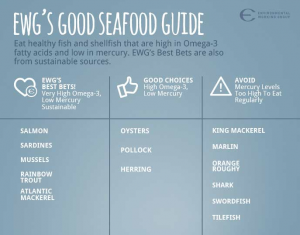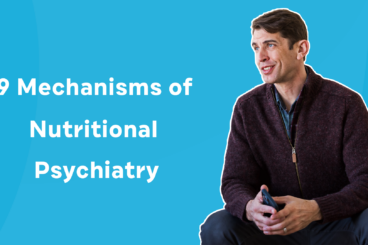Heard the buzz about omega-3s? Good for inflammation, brain health, depression and even increasing IQ points in children… the list is endless. But for those of us who didn’t grow up eating seafood, getting in good quality Omega-3 fatty acids can be a challenge.
I became a vegetarian when I was 5. After hearing about how important Omega-3 fatty acids were for my health and wanting to diversify my protein sources, I decided to try integrating fish a few years ago.
Seafood is one of the Food Categories that we talk a lot about in our work and in the Eat To Beat Depression e-course. Since I also struggled with adding seafood into my diet, I wanted to offer up some of the tips that have helped me and our patients. For those of you new to seafood, scared of seafood (eating it or preparing it), or just plain distrustful of it, this blog is for you!
A quick reminder based in my clinical work. People often get impatient with change. Keep in mind that it takes time to find the right way for you to integrate new foods into your diet. Everyone has different tastes and preferences, and that’s not only ok, it’s awesome. We’d love to hear some of your favorite ways to get in your seafood fix in the comments below.
Eat it raw
I know, I know, it sounds nuts. But surprisingly, a lot of raw fish tastes and smells less fishy than cooked fish. Salmon is one of the best sources of Omega-3 fatty acids, but the taste, the texture, I just couldn’t do it. Until I tried it in sushi. It’s smooth rather than flaky, and it has less of a meaty texture.
If you’d like to try it raw but aren’t ready for sushi, you can also try a ceviche like this one from Eat Complete.
Scallop and Shrimp Ceviche with Pickled Ginger and Radishes
Serves 4
Ceviche makes for a fast, no-cook seafood dish that’s ideal for a fresh summer meal or a first-time recipe for seafood newbies. Shop for tangy pickled ginger in Asian grocery stores or opt for freshly thinly sliced ginger root in its place. If you don’t have an Asian market nearby, reserved the pickled ginger from your next sushi bar order to use here.
½ pound sea scallops, diced
½ shrimp, cut into 1-inch wide chunks
4 limes, juiced
2 tomatoes, chopped
4 radishes, thinly sliced
½ cup thinly sliced sweet white or red onion
2 tablespoons pickled ginger
1 tablespoon hot sauce, optional
2 avocados, cubed
16 large Romaine leaves (about 2 heads)
Place the scallops, shrimp, lime juice, tomatoes, radishes, red onion, pickled ginger, and hot sauce in a large bowl. Toss well and cover with plastic wrap. Refrigerate 15 to 20 minutes, until the scallops and shrimp are firm to the touch and no longer translucent. Stir in avocado Set out the 16 Romaine leaves and top with 3 heaping tablespoons ceviche, serve immediately.
Not into fish? Try muscles, clams or oysters
Bivalves are a top source of minerals like zinc and iodine, B12, and are a top source of long-chained omega-3 fatty acids. You can dress them up with sauces, eat them raw or grilled. Mussels and clams are great value in the grocery store. There are hundreds of breeds of oysters. If you are new to eating them raw, ask for small ones. Start by snagging a bite from someone else’s plate, or order a single oyster at a bar and experiment. You may be surprised!
Salad dressing
It’s kinda like hiding zucchini in your children’s bread, except instead of hiding veggies, we’re hiding anchovies. I’m hard-pressed to find someone who doesn’t like a Caesar salad. It may not be an everyday thing, but the key is to diversify your seafood sources. Give this Caeser dressing a go, and for an extra boost, switch out your romaine for kale.
En papillote
Yes, when you give your seafood a French name, it tastes better. En papillote is a method of baking fish in parchment paper. I like it as it’s a no-fail method to preparing fish. And even better news, baking fish takes under 20 minutes. You can also add a layer of foil and use this technique on the grill. Check out these favorites:
Grilled Whole Trout in Parchment Paper with Garlic Broccoli
Simple in a saute pan
One of my favorite ways to cook fish is also the simplest. I take a filet, salt both sides, then put some of my favorite spice mix on a plate (curry powder, fleur de provence, smoked paprika with cumin etc) and dip both sides of the fish in the spice mix so they are coated in delicious flavor. I put about 1 tablespoon of coconut or olive oil in a pan and when it’s hot, I put the fish in. I cook it for 2-3 minutes on each side (until it’s no longer translucent) and we’re done! So quick, so easy, so flavorful.
Use it as a topping
Who doesn’t love pizza? Great! Pizza night? Add some clams. Bagels and cream cheese? Let’s add some smoked salmon. Gluten free? Make cucumber rolls with cream cheese and smoked salmon. The world is your oyster (ha). Don’t feel pressure to make seafood the main component of your meal. Enjoy exploring and let us know.
So what’s the recommendation?
Try to eat seafood rich in Omega-3 fatty acids 2-3 times per week. We know there is concern over sustainability, mercury and other toxins, so here’s a handy graph of the types of fish we recommend.
A note on preparing fish:
One reason I find a lot of folks don’t like to cook fish is because 1. It’s expensive 2. It goes bad quickly 3. They don’t know how to cook it.
Buying frozen fish is a great way to save. To defrost, just put in the fridge the night before. This is a great way to move fish from being something you need to plan way in advance (getting to the market the day of “the event”) to something you can whip up quickly if you don’t have much around. Buying your fish frozen also takes some of the pressure off to cook it right away. Canned seafood is also a great way to go when it comes to clams, anchovies, sardines, tuna and salmon.
Want more individualized tips? Schedule an appointment with Samantha here.
Samantha Elkrief, LMSW is a therapist, holistic health coach and health-supportive chef. She is an action-oriented supportive psychotherapist and has trained in Cognitive Behavior Therapy (CBT), Mindfulness Based Stress Reduction (MBSR) and incorporates various mind-body practices into her clinical work. She is the clinical coordinator at the Brain Food Clinic and works with individuals struggling with anxiety, depression, work life balance, and unhealthy relationships with food.
Using Food as Medicine, she helps patients find a place of contentment and ease with food. She has expertise in plant-based diets, nutritional support for mental health and frequently works with clients with food sensitivities, allergies, and other medical concerns.
Samantha received her Masters Degree in Social Work from Columbia University and her health coach certification from the Institute for Integrative Nutrition. She trained as a chef at The Natural Gourmet Institute, where she also teaches.
She regularly appears as a guest on podcasts and her work has been featured in the NY Post, MindBodyGreen, Social Work Today, Eat Up New York, and on NBC.





I hear bad things about farm raised fish, and wonder is it better to eat farm raised salmon than no salmon at all? (or other farm raised fish/shellfish) Wild caught is so expensive. Thanks!
Hi Amanda, thanks for your question! Yes, it’s definitely better to eat farm-raised salmon than no salmon at all! Frozen seafood is another great way to get a high-quality product that is less expensive. There are also great sources of Omega-3s that are less expensive, like anchovies, sardines and mussles.